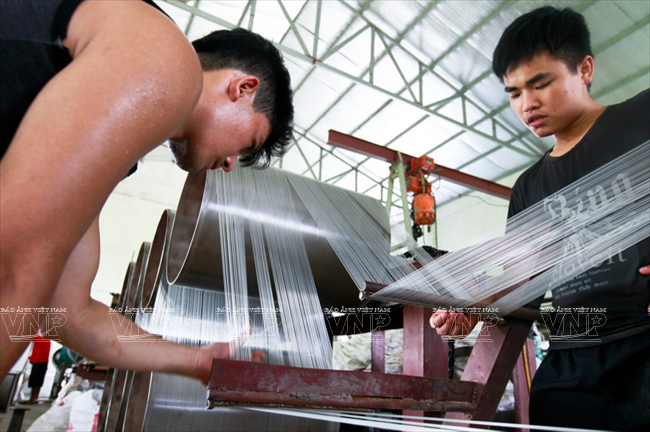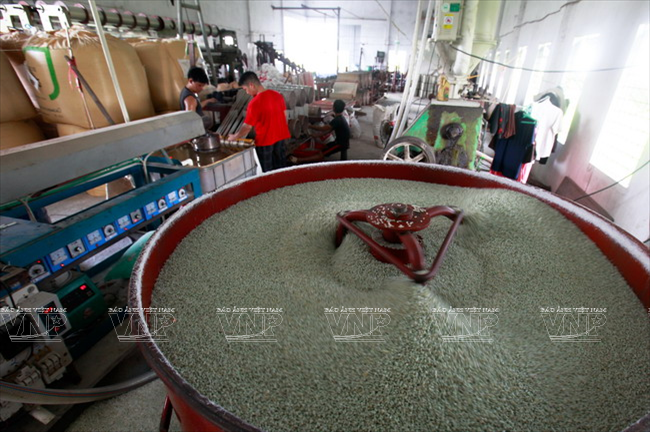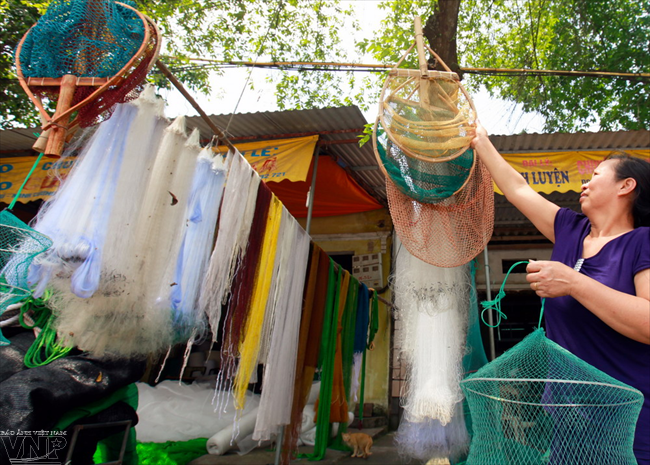Visiting the family of Dinh Ngoc Khuyen, one of the households involved in making fishing nets for many years in the village, we learnt much about the history of this craft village. According to the village’s historical document, the village was built in 1428 and a woman, called “Holy Mother” was considered the villagers’ craft ancestor. It is said that the Holy Mother was a native from Thanh Hoa Province who migrated to the village. When visiting the village, the king met her and took her to the palace. However, after several years of living with the king, she did not have any child so she asked the king to allow her to return to the village where she then taught the locals how to make nets from plastic thread.
“Since I was a boy I saw people making fishing nets,” said Khuyen. He added that he himself began doing some stages of making fishing nets at the age of 5-6 and he was able to make small fishing nets for catching fish when he was 12. During the 1982-1983 period, the manufacturing process remained completely by hand and it took them much time and efforts. A simple net required three to five craftsmen with each specialising in just one step of the complex weaving process. The net weavers of Tran Phu village began as idle farmers passing time between harvests and have developed into a group of internationally-recognised industrialists.
….to Tran Phu net brand.
The years of 1996 and 1997 marked the turning point of the village’s craft because many stages of making fishing nets started being done by machines that helped shorten the time and the locals only had to focus on the important stages. Furthermore, the market at that time saw a great change and their customers have expanded beyond fishermen to include farmers and contractors who use the nets to protect rows of flowers or vegetables from birds and to encircle construction sites. Thanks to the increasing demand of the market, the village’s craft strongly developed and made a great leap forward. Many households invested in making high-class nets and developed their own trademark, such as Khuyen Hien.
The village now has 100 households involved in trading and producing nets. The production workshop of Khuyen’s family now consists of 100 workers, including 10 skilled craftsmen who are paid 150,000-200,000 VND/day while the elderly locals are contracted to do the fine work at home for around 50,000-70,000 VND/day.

Production methods at Tran Phu village have changed to meet the market demand and the net-producing workshop of
Dinh Ngoc Khuyen, one of the biggest net-producing workshops at Tran Phu is a typical example. Photo: Viet Cuong/VNP

Workers run the thread processing machine at a workshop in Tran Phu Village. Photo: Viet Cuong/VNP

Workers at net-producing workshops have an average income of 5 to 7 million dong per month. Photo: Viet Cuong/VNP

Each net-producing workshop employs from 9 to 10 villagers. Photo: Viet Cuong/VNP

Dây chuyền, máy móc thiết bị sản xuất ở làng cước Trần Phú hiện được đầu tư hiện đại.
Modern machines used for net production in Tran Phu Village. Photo: Viet Cuong/VNP

Nets at a workshop in Tran Phu Village. Photo: Viet Cuong/VNP

Customers choose fishing nets in Tran Phu Village. Photo: Viet Cuong/VNP

Fishing nets made in Tran Phu Village (Minh Cuong Commune – Thuong Tin, Hanoi). Photo: Viet Cuong/VNP |
Khuyen also took us to visit the production workshop of Nguyen Van Quy, one of the largest factories in the village which needs about 90 tonnes of thread for production each month.
Previously, to get raw thread for production the villagers depended on unreliable imports from Japan and Singapore and they never thought of buying modern machines for making nets. Today, there are many modern production workshops in the commune which were invested in with billions of dong. For example, Quy’s workshop has two thread weaving machines and two net producing machines. The average income of each employee in his workshop is 5-7 million dong/month, even 10-12 million dong at peak time. His family also signed contracts with 30 households to weave nets.
Tran Phu has become a recognised brand across the country, as well as in China, Laos and Cambodia, creating jobs for the village’s 1,500 residents and a number of migrant labourers.
Thanks to a sound policy, great effort and creativeness in trade and production, Tran Phu Village is honored with the title “A Traditional Craft Village” by the Hanoi People’s Committee./.